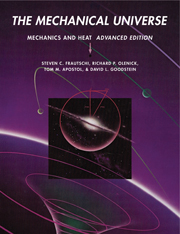Book contents
- Frontmatter
- Contents
- Preface
- Chapter 1 INTRODUCTION TO THE MECHANICAL UNIVERSE (Program 1)
- Chapter 2 THE LAW OF FALLING BODIES (Program 2)
- Chapter 3 THE LANGUAGE OF NATURE: DERIVATIVES AND INTEGRALS
- Chapter 4 INERTIA
- Chapter 5 VECTORS
- Chapter 6 NEWTON'S LAWS AND EQUILIBRIUM
- Chapter 7 UNIVERSAL GRAVITATION AND CIRCULAR MOTION
- Chapter 8 FORCES
- Chapter 9 FORCES IN ACCELERATING REFERENCE FRAMES
- Chapter 10 ENERGY: CONSERVATION AND CONVERSION
- Chapter 11 THE CONSERVATION OF MOMENTUM
- Chapter 12 OSCILLATORY MOTION
- Chapter 13 ANGULAR MOMENTUM
- Chapter 14 ROTATIONAL DYNAMICS FOR RIGID BODIES
- Chapter 15 GYROSCOPES
- Chapter 16 KEPLER'S LAWS AND THE CONIC SECTIONS
- Chapter 17 SOLVING THE KEPLER PROBLEM
- Chapter 18 NAVIGATING IN SPACE
- Chapter 19 TEMPERATURE AND THE GAS LAWS
- Chapter 20 THE ENGINE OF NATURE
- Chapter 21 ENTROPY
- Chapter 22 THE QUEST FOR LOW TEMPERATURE
- Appendix A THE INTERNATIONAL SYSTEM OF UNITS
- Appendix B CONVERSION FACTORS
- Appendix C FORMULAS FROM ALGEBRA, GEOMETRY, AND TRIGONOMETRY
- Appendix D ASTRONOMICAL DATA
- Appendix E PHYSICAL CONSTANTS
- SELECTED BIBLIOGRAPHY
- Index
Chapter 1 - INTRODUCTION TO THE MECHANICAL UNIVERSE (Program 1)
Published online by Cambridge University Press: 05 August 2013
- Frontmatter
- Contents
- Preface
- Chapter 1 INTRODUCTION TO THE MECHANICAL UNIVERSE (Program 1)
- Chapter 2 THE LAW OF FALLING BODIES (Program 2)
- Chapter 3 THE LANGUAGE OF NATURE: DERIVATIVES AND INTEGRALS
- Chapter 4 INERTIA
- Chapter 5 VECTORS
- Chapter 6 NEWTON'S LAWS AND EQUILIBRIUM
- Chapter 7 UNIVERSAL GRAVITATION AND CIRCULAR MOTION
- Chapter 8 FORCES
- Chapter 9 FORCES IN ACCELERATING REFERENCE FRAMES
- Chapter 10 ENERGY: CONSERVATION AND CONVERSION
- Chapter 11 THE CONSERVATION OF MOMENTUM
- Chapter 12 OSCILLATORY MOTION
- Chapter 13 ANGULAR MOMENTUM
- Chapter 14 ROTATIONAL DYNAMICS FOR RIGID BODIES
- Chapter 15 GYROSCOPES
- Chapter 16 KEPLER'S LAWS AND THE CONIC SECTIONS
- Chapter 17 SOLVING THE KEPLER PROBLEM
- Chapter 18 NAVIGATING IN SPACE
- Chapter 19 TEMPERATURE AND THE GAS LAWS
- Chapter 20 THE ENGINE OF NATURE
- Chapter 21 ENTROPY
- Chapter 22 THE QUEST FOR LOW TEMPERATURE
- Appendix A THE INTERNATIONAL SYSTEM OF UNITS
- Appendix B CONVERSION FACTORS
- Appendix C FORMULAS FROM ALGEBRA, GEOMETRY, AND TRIGONOMETRY
- Appendix D ASTRONOMICAL DATA
- Appendix E PHYSICAL CONSTANTS
- SELECTED BIBLIOGRAPHY
- Index
Summary
In the center of all the celestial bodies rests the sun. For who could in this most beautiful temple place this lamp in another or better place than that from which it can illuminate everything at the same time? Indeed, it is not unsuitable that some have called it the light of the world; others, its minds, and still others, its ruler. Trismegistus calls it the visible God; Sophocles' Electra, the all-seeing. So indeed, as if sitting on a royal throne, the Sun rules the family of the stars which surround it.
Nicolaus Copernicus in De Revolutionibus Orbium Coelestium (1543)THE COPERNICAN REVOLUTION
We find it difficult to imagine the frame of mind of people who once firmly believed the earth to be the immovable center of the universe, with all the heavenly bodies revolving harmoniously around it. It is ironic that this view, inherited from the Middle Ages and handed down by the Greeks, particularly Greek thought frozen in the writings of Plato and Aristotle, was one designed to illustrate our insignificance amid the grand scheme of the universe – even while we resided at its center.
Aristotle's world consisted of four fundamental elements – fire, air, water, and earth – and each element was inclined to seek its own natural place.
- Type
- Chapter
- Information
- The Mechanical UniverseMechanics and Heat, Advanced Edition, pp. 1 - 10Publisher: Cambridge University PressPrint publication year: 1986



